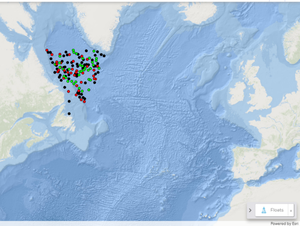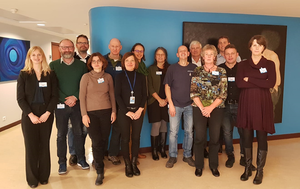C-SCOPE will focus on the ocean’s CO2 uptake capacity in three key regions which are of highest climatic and/or socioeconomic relevance and hence in need of knowledge-based stewardship:
- the thermohaline circulation system in the North Atlantic Ocean,
- the Amazon rainforest system in South America, and
- the Baltic Sea
To achieve this, the project is split into four work packages.
WP 1 Connecting BGC-Argo and SOOP
BGC-Argo will allow – in a so far unthinkable way – observations of the oceanic uptake of CO2 and the impact of anthropogenic influences on marine biogeochemistry and thus on marine biota. This opens up completely new perspectives in the assessment of these impacts on marine ecosystem services and marine biological resources. However, near-surface float-based C measurements suffer from systematic biases which significantly limit data quality in the most critical upper ocean layer.
The existing SOOP network for surface ocean observation of CO2 and ancillary parameters is an established source of routine data of known quality which are the backbone for estimating the ocean’s CO2 sink. However, the SOOP network being restricted to surface observations, lacks the important link to the ocean interior dynamics (i.e., the third dimension) which can be provided by BGC-Argo. Connecting BGC-Argo and SOOP will be highly synergistic and provide access to (i) an otherwise hardly achievable data quality and (ii) robust operational data products for key functions of the ocean which are required to assess the state of the ocean and both its susceptibility and feedback potential to global change.
Task 1.1 (BSH, IDOS, IOW, GEOMAR)
The work aims at consolidating the data basis of float-based pH measurements in the subpolar Atlantic by connecting to the pilot studies of the BMBF-funded projects OA_TWS_IOC and DArgo2025. To achieve this BSH will extend available time series in time and space by float deployments in 2022-2023. Six Argo floats (3 per year) from the operational German Argo program will be upgraded with additional oxygen and pH sensors and deployed along the SOOP line. To support the analysis information on the convection activity in the Labrador Sea and seasonal to interannual variability in hydrographic and biogeochemical parameters will be provided from the existing float data set in the area.

Float data set in the Labrador Sea (green=active, red/black=dead)

pH measurements performed by float 6904114 in the Labrasdor Sea
Task 1.2 (IOW, BSH, IDOS, GEOMAR)
IOW's contribution comprises as observation component a demonstration study in the Baltic Sea on the synergistic combination of BGC-Argo with an existing Ship of Opportunity Line (SOOP) of the SOCONET/ICOS network. In addition to testing and implementing a pCO2 sensor as a second CO2 parameter on BGC-Argo floats, it will serve to quantify and deepen the understanding of oceanic CO2 uptake in relation to anthropogenic drivers, which will also be achieved through close cooperation between the observation component and ecosystem modelling at IOW.

NKE Provor CTS5 BGC-Argo Float with integrated Contros HydroC pCO2-Sensor (credit nke Instrumentation)
Task 1.3 (GEOMAR, BSH, IOW)
BGC-Argo/SOOP Datenproducts, combined analysis of high resolution CO2 data from water column and profiles. (Arne and Tobi).
WP 2 Brazilian SOOP for Seamless Observation across the Land-Ocean Aquatic Continuum (LOAC)
Human activities and practices in the Amazon river and its shelf system (e.g., land-use and land-cover changes, agriculture, construction of dams, etc.) have high potential to exert cascading effects on the LOAC of the Amazon basin. The hydrological regime (run-off, groundwater circulation, freshwater export to coastal and open ocean waters), CO2 emissions to the atmosphere, and lateral carbon fluxes from the land to the ocean are all particularly expected to be affected. This intricate causal chain is located between the scopes of terrestrial and marine observation networks. Filling this critical observational gap and understanding the complexity of the LOAC between the Amazon and the tropical Atlantic Ocean is required for for reliable prediction of the impact of human activities and the development of evidence-based management options. Amazonia, a region with recently dramatically increased deforestation pressure that may soon reach a critical rainforest dieback tipping point (Jones et al. 2008), is thus arguably the best case for a LOAC-wide observation system. The WP2 of the C-SCOPE project evolves in the close interaction between in-situ high resolution measurements of the carbon system (Task 2.1) and numerical models (Task 2.2) in the Amazon shelf system.
Task 2.1 (GEOMAR, IDOS, FSU, UERJ)
Development and operation of Brazilian SOOP. (Arne and Leticia).
Task 2.2 (FSU, GEOMAR, UERJ)
Task 2.2 aims to numerically simulate the horizontal and vertical fluxes of carbon between the Amazon river and its shelf system at the tropical Atlantic Ocean. For this, a regional configuration for this area will be constructed using a general circulation model that includes the physical ocean and a biogeochemistry component. The model output will be calibrated and evaluated mostly with the newly obtained high-resolution data of carbon-related parameters measured with the SOOP-Brazil line developed in Task 2.1.
WP 3 Operationalizing and Socializing Marine Observations
An improved understanding of CO2 drivers and dynamics as well as associated time scales directly aids in better predicting CO2 uptake capacity as a basis for sustainable management. State-of-art technologies and methods, ranging from platforms and sensors to quality control and evaluation schemes, are a pre-requisite for an Earth observation system of systems that is fit for purpose. Scientific-technological methods alone, however, do neither assure sustainable operation nor optimal use and acceptance of the resulting data-based products and knowledge. WP3 specifically addresses this by exploring ways of operationalization (Task 3.1) and socialization (Task 3.2) of marine observations with the ultimate goal of sustained operation and optimal usage of the achieved knowledge across all stakeholders and cultures involved.
In order to perfect and expand marine carbon observation as well as to allow the transfer to other coastal marine regions, the demonstration study in the Baltic Sea will be used as a basis for an estimation of optimised observation parameters (qualitative and quantitative) in order to effectively and sustainably determine the CO2 uptake capacity and to detect anthropogenically induced changes at an early stage that allows countermeasures to be taken, if necessary.
The results obtained can then be translated into concrete recommendations for action using existing structures in the Baltic Sea region such as Baltic Earth and HELCOM. Furthermore, they are to be incorporated into a national implementation plan for the sustainable organisation of marine carbon measurements within the framework of ICOS and BGC-Argo in order to provide reliable CO2 data for research and the generation of socially relevant applications.
Task 3.1 (BSH, IDOS, IOW, GEOMAR)
The work of BSH in cooperation with the Intergovernmental Oceanographic Commission (IOC) is aiming at securing and improving the data on SDG indicator 14.3.1 (ocean acidification) and supporting the role of IOC as custodian agency.


In cooperation with IDOS and GEOMAR BSH is exploring options for securing long-term financing and administrative structures for marine CO2 observations. The partners will discuss a national implementation strategy for a sustainable long-term monitoring network linking (GOA-ON, ICOS, Argo). The process is aiming at integrating a social science approach to ensure transparency and engagement with scientists and the political parties in the relevant federal ministries (BMBF, BMDV, BMUV)
Task 3.2 (IDOS, BSH, IOW, GEOMAR, UERJ)
Task 3.2 investigates which cognitive, technological, social and political processes play a role in the production of scientific knowledge on marine carbon observations. To that end, it looks at
- the structural dimensions of knowledge production in marine carbon observations – i.e. the value chain of marine CO2 observations, including the various steps from how data is gathered to how it enters the policy processes, as well as the provision of funds and the formation of scientific agendas – in relation to the North Atlantic, the Baltic See and the coastal and Amazon regions in Brazil, as well as
- the daily practices of interdisciplinary and transcultural scientific collaboration within the project.
Under the catchphrase of ‘Open Ocean Science’, the project aims to create a concept for broadening up scientific agenda setting to include diverse stakeholders, and for scientific practices that address inequalities in terms of who has access to and who benefits from marine carbon observations. Jointly, project partners and stakeholders develop targeted and specific recommendations for ocean science that is transparent, accessible and relevant across multiple epistemic groups. In doing so, the project contributes to the goals of the UN Decade of Ocean Science for Sustainable Development, namely those of creating ‘an accessible ocean with open and equitable access to data’ as well as to ‘an inspiring and engaging ocean‘.
WP 4 Coordination
(GEOMAR)
WP4 will be supported by an experienced senior postdoc (Dr. Steinhoff) and will have a central budget for support of the observational and other joint tasks. The coordinator will monitor and mediate timely data delivery to the data centers according to the work plan and the data management concept.


